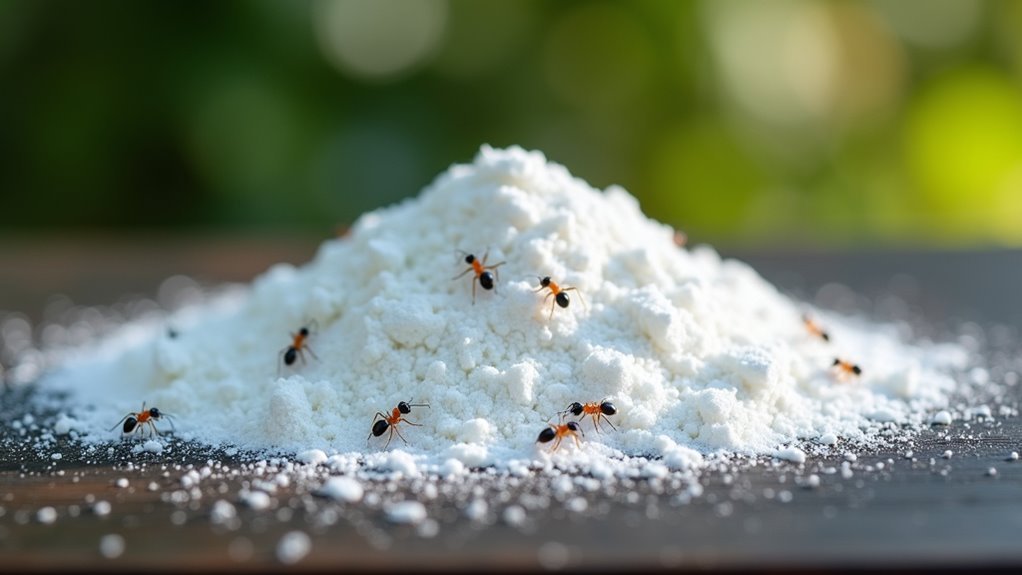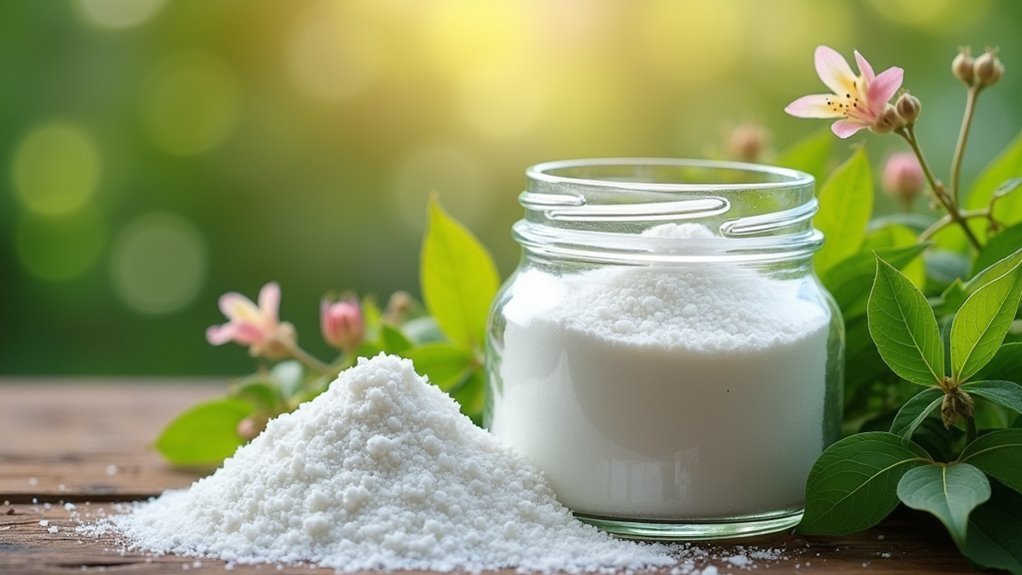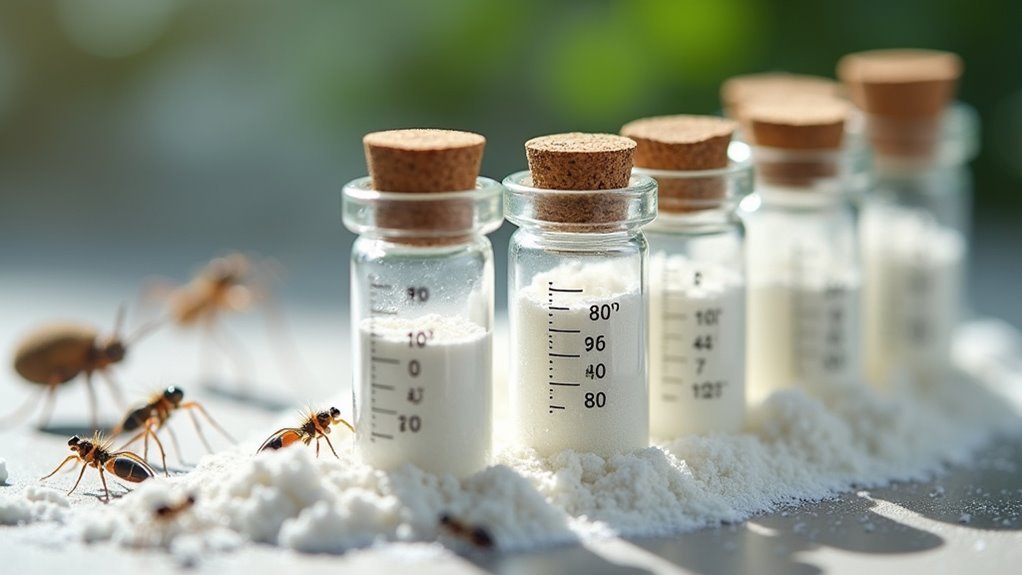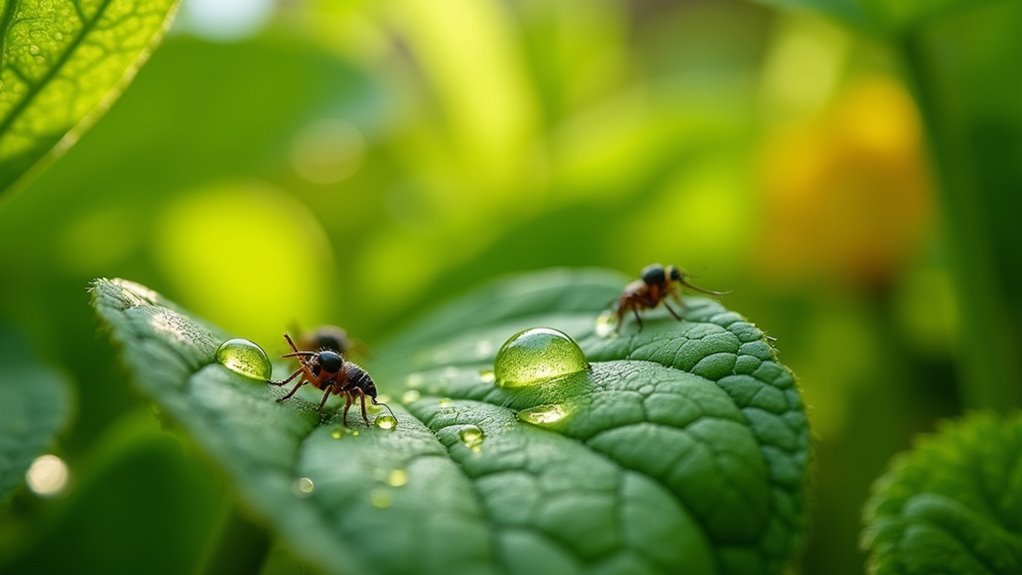You’ll need borax concentrations between 3-10% depending on your target pest. For ants, mix 5% borax with sugar water, while cockroaches require 3-5% concentrations for effective elimination. Fire ants and other resilient species demand higher levels up to 10%. Start with moderate concentrations of 2-3% during initial infestations, then adjust based on pest activity levels. Regular monitoring and reapplication guarantee successful colony elimination. Understanding proper mixing ratios and application methods will maximize your pest control success.
Understanding Borax as a Pest Control Agent

Borax stands as one of the most reliable natural pest control solutions available to homeowners. This sodium borate compound delivers effective pest control by targeting ants, cockroaches, and termites through digestive system disruption.
When pests consume borax, it dehydrates their bodies and damages their exoskeletons, causing death within days of ingestion.
You’ll find borax particularly valuable because it’s relatively safe for humans and pets when used in low concentrations. The compound works strategically—pests carry the substance back to their nests, eliminating entire colonies rather than individual insects.
This makes borax more effective than surface sprays that only kill visible pests. Its dual action of attracting target insects while remaining less harmful to household members positions borax as an intelligent choice for residential pest management.
Optimal Borax Concentrations for Different Pest Types
You’ll need to adjust borax concentrations based on your specific pest problem, as different insects require different lethal dosage levels to achieve effective elimination.
For ant colonies, you’ll find that lower concentrations work best since worker ants must carry the poison back to eliminate the entire nest, while cockroaches need stronger direct-contact formulations.
When determining your concentration levels, you must balance effectiveness against safety guidelines to protect your family and pets from accidental exposure.
Ant Colony Elimination Rates
When targeting different ant species, concentration levels determine the success of your elimination efforts.
You’ll achieve ideal ant colonies elimination by using 5% Borax concentration mixed with sugar water, which attracts worker ants effectively. They’ll transport this active ingredient back to their nest, poisoning the entire colony systematically.
For resilient species like fire ants, you’ll need higher concentrations up to 10% Borax to guarantee effective control.
Deploy these solutions in bait stations to maintain proper concentration while protecting non-target organisms from exposure.
Your success depends on consistent monitoring and reapplication every few days.
This continuous exposure strategy guarantees complete colony elimination rather than just killing individual ants you see foraging around your property.
Cockroach Lethal Dosage Levels
Cockroaches require different concentration strategies than ants due to their larger size and varied feeding habits. You’ll need Borax at 3-5% concentrations to achieve effective cockroach lethal dosage levels. When cockroaches consume this mixture through ingestion, it disrupts their digestive systems, causing dehydration and death.
| Borax Application Method | Mortality Rate Timeline |
|---|---|
| 1:1 Borax-sugar mixture | 90%+ within 72 hours |
| 3-5% concentration | Ideal lethal dosage |
| High-traffic placement | Maximum ingestion likelihood |
| Consistent reapplication | Sustained effectiveness |
You’ll achieve mortality rates exceeding 90% within 72 hours when applying proper dosages. Place your Borax mixture where cockroaches frequently travel, as their feeding behavior determines success. Maintain consistent application since residual effects decrease over time without reapplication.
Safety Concentration Guidelines
Although Borax proves effective against multiple pest types, different insects require specific concentration levels to achieve ideal results while maintaining household safety.
You’ll find these safety concentration guidelines guarantee low toxicity while maximizing pest elimination effectiveness.
When applying Borax to control pests, follow these critical safety measures:
- Never exceed recommended concentrations – Higher levels won’t improve results but increase the potential to cause harm to your family and pets.
- Always read the product label thoroughly – Manufacturers provide specific mixing ratios tested for both efficacy and safety.
- Keep treated areas inaccessible to children and animals – Even low-toxicity formulations can pose risks with direct contact or ingestion.
Public health experts recommend starting with lower concentrations and gradually increasing if needed, guaranteeing you maintain the delicate balance between pest elimination and household safety.
Borax Bait Formulations and Mixing Ratios
Effective borax bait formulations rely on precise mixing ratios that balance lethality with attractiveness to target pests.
Successful pest elimination requires careful calibration between toxic potency and irresistible bait appeal to achieve maximum colony penetration.
You’ll need to combine one part borax with three parts sugar, adding water until you achieve a syrupy consistency. This ratio guarantees your active ingredients remain potent while the sugar-based attractant successfully lures ants and cockroaches. Effective concentrations typically range from 5% to 10% borax in your mixture.
Place your bait in tamper-resistant stations to protect children and pets while allowing target pests access.
You must refresh the bait every few days since sugar loses its appeal over time. This slow-acting poison works perfectly for pest control because insects carry the mixture back to their colonies, eventually eliminating entire populations through delayed toxicity.
Safety Considerations When Using Borax for Pest Control

While mixing your borax bait requires careful attention to ratios, you’ll also need to prioritize safety considerations throughout the entire application process. Despite borax’s low toxicity rating, health risks still exist, especially for children and pets who might accidentally ingest the substance.
Your application must include these essential safety measures:
- Wear protective gear – Don gloves and masks to prevent skin irritation and respiratory issues that could harm you during treatment.
- Keep children and pets away – Store and apply borax in areas completely inaccessible to curious hands and paws.
- Never mix with other chemicals – Combining substances can create dangerous reactions that put your family at risk.
Always follow label instructions precisely to guarantee both effective pest elimination and household safety.
Application Methods for Maximum Effectiveness
Once you’ve prepared your borax mixture with proper safety protocols, strategic placement becomes essential for targeting pest traffic patterns effectively.
Application methods greatly impact your success rate when controlling pests. Direct contact remains critical for most treatments to work properly.
For insecticidal soaps, apply at 2-3% concentration directly onto soft-bodied pests like aphids, ensuring complete coverage.
You’ll need to wet insects thoroughly since effectiveness depends on disrupting their cell membranes through direct contact.
Horticultural oils work best at 2% concentration against armored scales.
Spray directly onto target areas where pests congregate.
Microbial biopesticides like Bacillus thuringiensis require precise application rates according to label instructions for maximum effectiveness.
Factors That Influence Borax Concentration Requirements

Beyond application techniques, several key factors determine the exact borax concentration you’ll need for successful pest elimination.
Different pests require varying concentrations—ants and cockroaches typically need lower amounts than other insects. Your chosen formulation greatly impacts effectiveness, whether you’re using powder, bait, or mixed solutions.
Environmental factors like humidity and temperature affect how borax interacts with pests, requiring concentration adjustments.
When pests have abundant alternative food sources, you’ll need higher concentrations to guarantee they consume lethal doses. However, longer exposure times allow lower concentrations to work effectively.
Consider these critical factors:
- Pest vulnerability varies dramatically – some insects succumb quickly while others resist
- Weather conditions can sabotage your efforts unexpectedly
- Competition from other food sources threatens your success
Common Mistakes in Borax Pest Control Preparations
You’ll likely encounter several pitfalls when preparing borax-based pest control solutions that can greatly reduce their effectiveness.
The most frequent errors involve mixing incorrect dilution ratios, applying treatments at the wrong times, and overlooking essential safety measures.
These mistakes can turn what should be an effective pest control strategy into a waste of time and resources.
Incorrect Dilution Ratios
When you’re mixing borax for pest control, getting the concentration wrong represents one of the most critical errors that’ll sabotage your efforts before they even begin. Your dilution ratio directly determines whether you’ll achieve effective pest elimination or waste time with ineffective solutions.
Three devastating mistakes plague homeowners attempting borax pest control:
- Under-diluting below 5% – Your solution becomes too weak to kill stubborn pests like ants and cockroaches.
- Over-concentrating above 10% – You’re creating dangerous toxicity levels threatening your family and pets.
- Using imprecise measurements – Cups instead of scales create inconsistent concentrations that undermine results.
You must follow specific guidelines religiously, as even slight deviations dramatically impact effectiveness.
Precise concentration control separates successful pest elimination from frustrating failures that leave infestations thriving.
Poor Application Timing
Timing your borax applications incorrectly can instantly transform an otherwise perfect pest control strategy into a complete failure.
Poor application timing during daylight hours leads to diminished effectiveness since most pests aren’t active and won’t encounter your bait. You’re wasting effort if you don’t target periods of high pest activity when they’re actively foraging.
Weather timing matters equally. Applying borax after rain or heavy dew washes away your preparations, preventing pest ingestion entirely. This results in ineffective pest control and wasted resources.
Don’t forget maintenance timing either. You must replace borax bait regularly before it dries out or loses appeal.
Fresh bait guarantees continued attraction and consumption, maintaining your pest control effectiveness throughout the treatment period.
Inadequate Safety Precautions
Inadequate safety precautions create serious risks that many overlook when preparing borax pest control solutions.
You’re exposing yourself and others to preventable dangers when you skip essential protective measures.
Critical safety failures that put lives at risk:
- Skipping personal protective equipment (PPE) – You’ll suffer skin irritation and respiratory problems without proper gloves and masks.
- Ignoring proper application rate guidelines – You’re creating environmental hazards that harm non-target organisms in your ecosystem.
- Placing treatments where children and pets can reach them – You’re risking severe ingestion risks that can lead to poisoning.
You must wear appropriate PPE, follow manufacturer instructions precisely, and secure treated areas.
Don’t let inadequate safety precautions turn your pest control efforts into a health emergency for your family.
Monitoring and Adjusting Borax Treatment Strength
Although borax proves effective against various pests, you’ll need to monitor and adjust your treatment concentration to maintain ideal results. Regular assessment of bait stations reveals whether your current Borax concentration effectively eliminates target pests or requires modification.
| Pest Activity Level | Borax Concentration | Action Required |
|---|---|---|
| High infestation continues | 1-2% | Increase to 3-4% |
| Moderate reduction observed | 2-3% | Maintain current level |
| Significant decline noted | 3-5% | Monitor for completion |
| Complete elimination achieved | Any effective level | Reduce for maintenance |
| Non-target species affected | Above 5% | Decrease immediately |
You’ll want to check effectiveness weekly, adjusting concentration based on pest resistance levels and species-specific responses. Combine monitoring with proper attractants like sugar to guarantee pests consume adequate dosages for successful elimination.
Comparing Borax Concentrations to Commercial Alternatives
When choosing between borax and commercial pest control products, you’ll find significant differences in concentration requirements, effectiveness timelines, and safety profiles.
Borax requires 5-10% concentrations for effective pest control, while commercial alternatives like insecticidal soaps contain only 1-5% boric acid.
You’ll notice these key differences:
- Speed matters – Commercial products kill on contact, while borax takes days to eliminate pests.
- Safety first – You’re exposing your family to fewer toxins with borax compared to potent commercial pesticides.
- Application flexibility – Commercial alternatives offer versatile methods, but borax demands strategic placement.
Both concentrations prove effective when applied correctly.
Commercial alternatives provide immediate results but require frequent reapplication, while borax offers longer-lasting control with safer handling for households with children and pets.
Frequently Asked Questions
What Is the Most Efficient Pest Control?
You’ll achieve the most efficient pest control by implementing Integrated Pest Management strategies that combine biological, mechanical, and chemical methods while using low-impact pesticides like insecticidal soaps at proper timing.
How to Calculate Concentration of Pesticide?
You’ll calculate pesticide concentration by dividing the active ingredient amount by total solution volume, then multiplying by 100. For dilutions, divide your desired percentage by the stock solution’s concentration to find the dilution factor.
What Are the Best Chemicals for Pest Control?
You’ll find abamectin, pyrethrins, and boric acid work exceptionally well for pest control. Consider using IGRs like pyriproxyfen for long-term prevention, while azadirachtin from neem offers effective, bee-safe organic control options.
Which Chemical Is Best for Pest Control?
You’ll find fipronil works best for most situations since it’s highly effective against ants, termites, and cockroaches at just 0.05-0.1% concentration, making it both potent and economical.
In Summary
You’ll find that borax concentrations between 2-5% work best for most household pests when mixed with attractive baits. Don’t exceed these ratios, as higher concentrations can repel insects rather than eliminate them. Always wear gloves and keep treatments away from children and pets. Monitor your bait stations regularly and adjust concentrations if you’re not seeing results within a week. Remember, patience is key—borax works slowly but effectively when you use the right concentration.





Leave a Reply